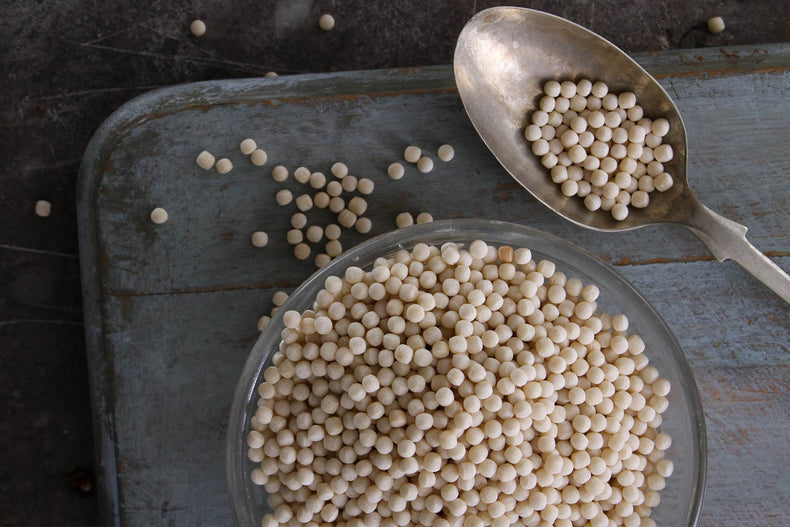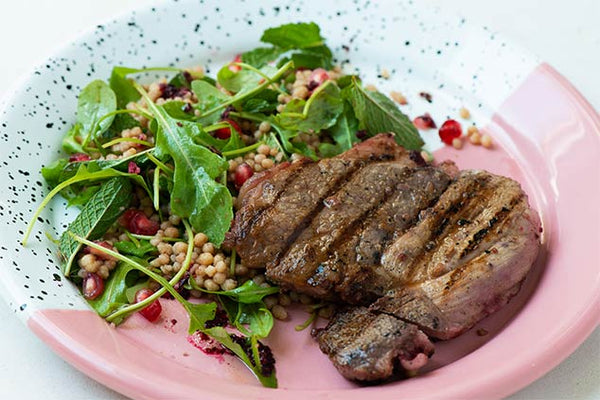The Ultimate Guide To Giant Couscous
by Ellie Edwards

What is giant couscous?
Don’t confuse giant couscous with couscous. Giant couscous are small balls of pasta and differ depending on the variety. Mograbiah is made by repeating the couscous-making process - gradually adding water to semolina and rolling it to create larger grains. Ptitim is made from wheat flour and water. Giant couscous has a bouncy texture, and, depending on the flour used, can have a slightly nutty flavour.
Couscous, on the other hand, is a tiny, yellow-hued grain. It is traditionally made from the hard part of the durum wheat kernel (semolina). The semolina is mixed with water to form the small grains. It is steamed and dried, with a fluffy texture. Couscous originates in North Africa, and can be used in place of rice and pasta.
While the name is often used in reference to the single ingredient, couscous is a dish in itself, popular in Morocco where the grain is served with a rich stew.
What is giant couscous made of?
In its simplest form, giant couscous is made from wheat flour and water. Often the wheat flour used is wholemeal which gives the pasta shape its distinctive nutty, earthy flavour.
Unlike couscous, giant couscous is dried, then toasted, which enhances the earthy flavours.
Where does giant couscous come from?
Giant couscous originates from Israel. It was created in the 1950s when, due to austerity, rice was hard to come by. Giant couscous was invented as an alternative.
While its history is in Israel, giant couscous is also associated with Palestine and Lebanon.
What is giant couscous called?
There are many names for giant couscous, and each variety differs slightly:
- It’s most often simply called ‘giant couscous’
- Ptitim, which literally translates as flakes in Hebrew, is its name in Israel. It is made by pushing dough through a mold, and then it is cut and toasted. It is mass-produced, rather than made by hand
- Ben-Gurion rice is another name for it. This is in reference to the prime minister at the time - David Ben-Gurion - who asked for the pasta to be created in the first place. Ben-Gurion rice and ptitim are the same thing and produced in the same way
- In Palestine, giant couscous is known as maftoul. Maftoul is an Arabic word derived from the root “fa-ta-la” which means to roll or to twist. Maftoul is made from bulgur and wholewheat flour and is rolled by hand. The balls are then left to dry in the sun
- Moghrabieh is a type of giant couscous that originates in Lebanon. The pasta shape is significantly larger than Israeli giant couscous
- Fregola or fregula tostata is a large Sardinian pasta, which is a good substitute for giant couscous. It is made with durum wheat semolina and water
Where to buy giant couscous
At Sous Chef, we sell maftoul, fregola and moghrabieh. Read more about each product below…
Zaytoun is a social enterprise, founded to support the resilience and livelihoods of Palestinians through fair trade. 100% of the company’s profits are reinvested into furthering this mission. This maftoul is cracked and hand-rolled by women, and the process is passed down through generations. It provides a sustainable source of income for women’s co-operatives in rural Palestine.
Morelli have been producing pasta for five generations, and siblings Lucia, Antonio and Marco still run the factory today. Morelli is unusual in that it includes the germ of the durum wheat in its pasta, to give it a better flavour. For a classic Sardinian dish, simmer the fregola in a tomato sauce and serve with clams.
How to cook giant couscous
How to cook giant couscous depends on the variety you’re using. If the pasta shape is larger, it’ll take longer to cook.
Follow the below instructions for cooking maftoul:
- Rinse the maftoul under cold water and place in a medium saucepan with the water or stock
- Bring to a boil and simmer over a low heat for 10 minutes
- Take the pan off the heat, put the lid on and let it stand for 10 minutes to allow the maftoul to absorb all the liquid
Due to its larger shape, moghrabieh needs to be simmered for 15-20 minutes, whereas fregola needs 12 minutes.
What to do with giant couscous
Giant couscous can be used in many ways. Bulk out soups and stews with the small pasta shape, add to salads, or use in place of rice in risottos and pilafs. Here are two salad ideas for using giant couscous.
Chargrilled Hibiscus-Marinated Lamb With Rocket, Mint, Giant Couscous and Pomegranate Salad

We’ve paired giant couscous with tangy pomegranate molasses, fresh mint and zingy pomegranate seeds in this fresh salad. Serve it alongside hibiscus-marinated lamb. Try it here.
Maftoul, Carrot, Feta, Date & Mint Salad Recipe

The rich grains of giant couscous are matched with roasted carrot, sharp feta, sweet dates and fresh mint for a hearty lunchtime salad. A tahini sauce drizzle gives a creaminess to the dish. Try it here.
For a truly delicious and vibrant dish, try pairing Israeli couscous with roasted vegetables like cherry tomatoes and red onion. The soft and slightly bit chewy texture of cooked couscous contrasts wonderfully with the toasted notes of pine nuts.
Drizzle with a bit of extra virgin olive oil, and sprinkle in some finely chopped herbs like parsley or cumin for an added burst of flavour. This makes an excellent side dish to grilled meats or even a hearty vegetarian main. If you're hosting, this dish will quickly become a firm favourite at gatherings.
Another versatile idea is to incorporate pearl couscous into a fresh, light salad with cucumber, raisins, and a touch of lemon zest for brightness. Add a bit of olive oil and season to your liking with a pinch of salt and pepper.
This salad is easy to make ahead and can be stored in an airtight container for up to a couple of days in the fridge. It’s the perfect go-to for a side dish or a quick weekday lunch, offering a great balance of flavours and textures.

About the author
Ellie Edwards is a food writer for Sous Chef. Previously she worked at olive magazine, writing about exciting new ingredients, UK restaurants and travelling the world to find the best cinnamon buns. When she's not exploring the likes of Belize, Kerala and Zanzibar, Ellie loves rustling up a feast in her London kitchen, with a particular passion for porridge, sourdough and negronis.



